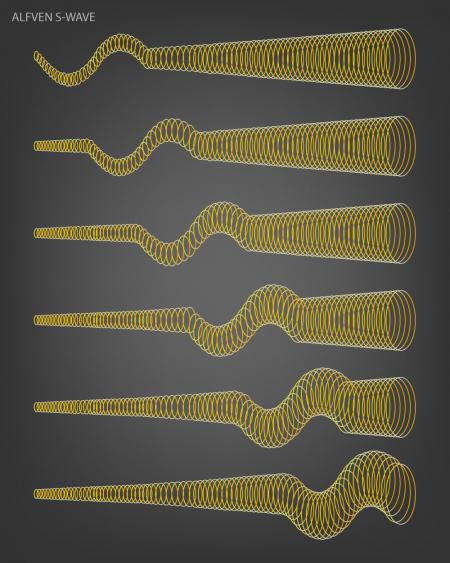07/09/2015
Fast-moving magnetic waves emanating from a distant supermassive black hole undulate like a whip whose handle is being shaken by a giant hand, according to a new study involving Caltech scientists, which used data from the National Radio Astronomy Observatory's Very Long Baseline Array (VLBA) to explore the galaxy-black hole system known as BL Lacertae (BL Lac) in high resolution.
The team's findings, detailed in the April 10 issue of the Astrophysical Journal, mark the first time so-called Alfvén (pronounced Alf-vain) waves have been identified in a black hole system.
Alfvén waves are generated when magnetic field lines, such as those coming from the sun or the disk around a black hole, interact with charged particles, or ions, and become twisted, and in the case of BL Lac and sometimes for the sun, are coiled into a helix. In the case of BL Lac, the ions are in the form of particle jets that are flung from opposite sides of the black hole at near light speed.
"Imagine running a water hose through a slinky that has been stretched taut," says first author Marshall Cohen, professor emeritus of astronomy at Caltech. "A sideways disturbance at one end of the slinky will create a wave that travels to the other end, and if the slinky sways to and fro, the hose running through its center has no choice but to move with it."
A similar thing is happening in BL Lac, Cohen says. The Alfvén waves are analogous to the propagating transverse motions of the slinky, and as the waves propagate along the magnetic field lines, they can cause the field lines—and the particle jets encompassed by the field lines—to move as well.
It's common for black hole particle jets to bend—and some even swing back and forth. But those movements typically take place on timescales of thousands or millions of years. "What we see is happening on a timescale of weeks," Cohen says. "We're taking pictures once a month, and the position of the waves is different each month."
Interestingly, from the vantage of astronomers on Earth, the Alfvén waves emanating from BL Lac appear to be traveling about five times faster than the speed of light. "The waves only appear to be superluminal, or moving faster than light," Cohen says. "The high speed is an optical illusion resulting from the fact that the waves are traveling very close to, but below, the speed of light, and are passing just to the side of our line of sight."
Co-author David Meier, a visiting associate in astronomy and now-retired astrophysicist from JPL, added, "By analyzing these waves, we are able to determine the internal properties of the jet, and this will help us ultimately understand how jets are produced by black holes."
Other authors on the paper, "Studies of the Jet in BL Lacertae II Superluminal Alfvén Waves," include Talvikki Hovatta, a former Caltech postdoctoral scholar; as well as scientists from the University of Cologne and the Max Planck Institute for Radio Astronomy in Germany; the Isaac Newton Institute of Chile; Aalto University in Finland; the Astro Space Center of Lebedev Physical Institute, the Pulkovo Observatory, and the Crimean Astrophysical Observatory in Russia. Purdue University, Denison University, and the Jet Propulsion Laboratory were also involved in the study.















